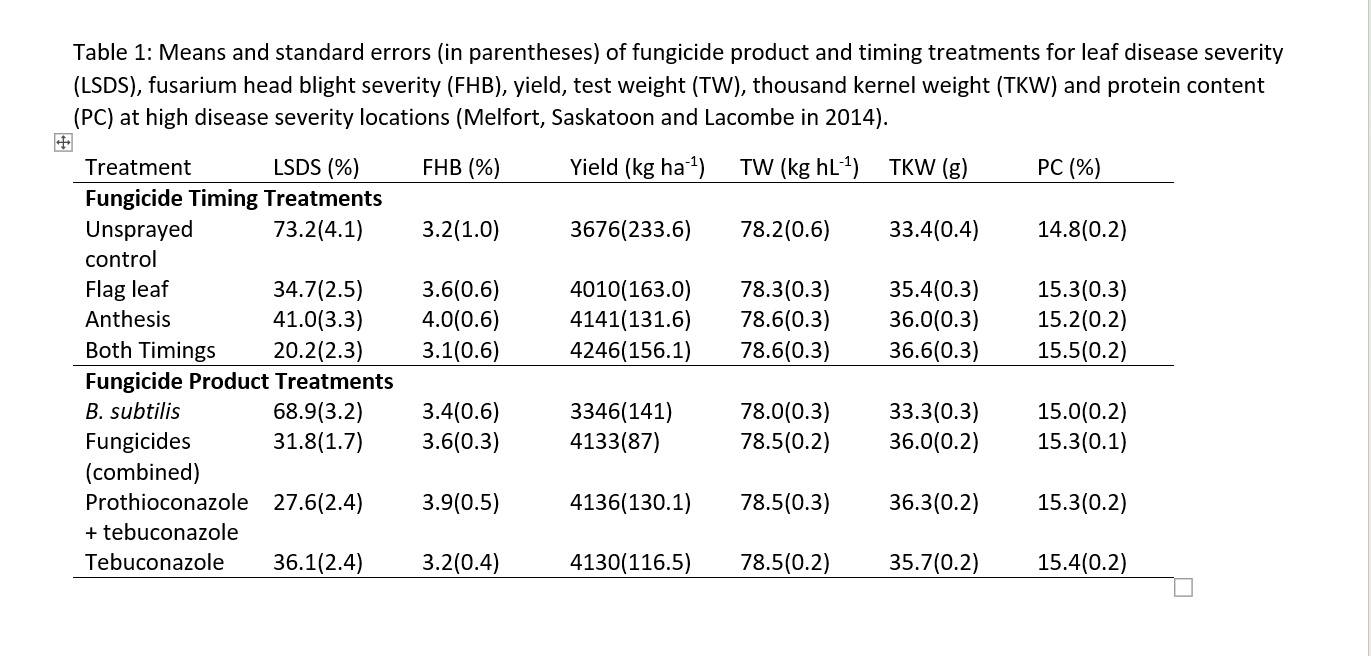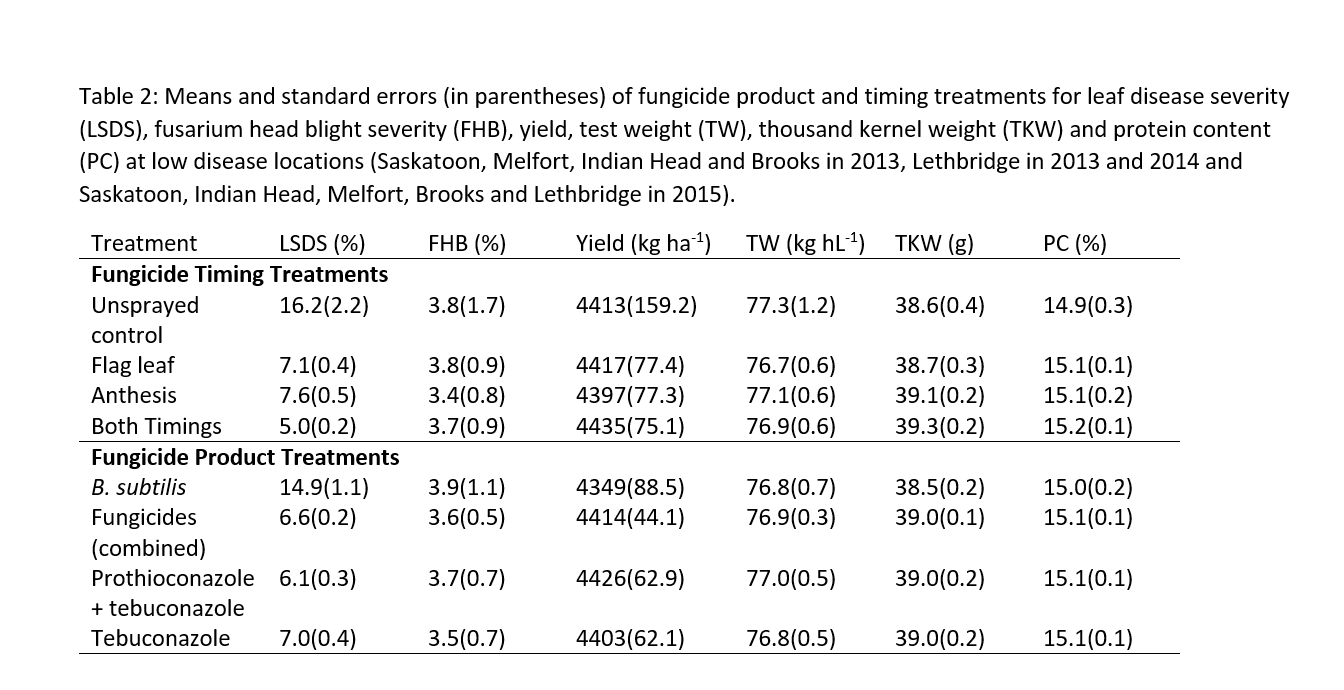Project AbstractLeaf spotting diseases commonly occur on spring wheat crops grown in Saskatchewan, causing yield losses of up to 15%, although greater losses have been documented during severe epidemics. In the past decade, Fusarium head blight (FHB) has become a major concern for growers resulting in extensive use of fungicide to mitigate the disease.The optimal fungicide timing for leaf spot control is generally at the flag-leaf stage, while the optimal timing for FHB is during anthesis. The objective of this study was to determine whether applying fungicide at anthesis timing can provide adequate control of leaf spots when compared to application at flag-leaf stage. Fungicide treatments applied at flag-leaf, anthesis, and both growth stages were evaluated on the cv. Carberry. Prothioconazole + tebuconazole and tebuconazole (only) applied at anthesis provided adequate control of leaf spots, although the severity of leaf diseases was slightly higher in this treatment than application at flag-leaf stage, but yields were similar. Test weight and thousand kernel weight were improved with the application at anthesis relative to that at flag-leaf stage. Two applications of fungicide provided only a small incremental benefit to the anthesis application and would not be economically justified in western Canada at this time. Anthesis fungicide application provided adequate leaf spot disease control and is the optimum timing for the control of FHB. |
|
||||||||||
Project Objectives
|
|
|
Methods |
|||||||||||||||||||||
|
|
||||||||||||||||||||
Measurements
The Canada Western Red Spring wheat variety 'Carberry' was chosen for this study as it is moderately susceptible to leaf spotting diseases, but moderately resistant to FHB. Disease ratings were conducted at the soft dough stage (ZGS 85). Leaf spotting disease severity was determined by assessing ten flag leaves and ten penultimate leaves from each plot using the Horsfall≥Barratt (0≥11) scale. Ratings were then converted to percent leaf area affected by the disease according to the grade formula specified in the scale. Fifty random spikes were assessed from each plot at the early dough stage of development for FHB severity (proportion of the spike bleached) by taking the average disease severity (%) of the 50 heads collected using the scale of Stack and McMullen (1995). Wheat yield, thousand kernel weight, test weight, and protein content were collected.
The data collected from each site-year were classified into high disease locations, where leaf-spot disease severity was 40% or greater in unsprayed checks, and low disease locations, where disease severity was less than 40%. Data from high disease site-years was combined, as was data from low disease site-years, and each analyzed separately. High disease locations included Saskatoon, Melfort and Lacombe in 2014, while all other site-years were considered low disease locations. Sub-samples of grains will be saved each year of the study.
Results
Final Results
In the high disease severity years, the mean leaf-spot disease severity of the unsprayed check was 73.2%, which was reduced to 32.0% by fungicide application. There were differences in disease severity among fungicide treatments with the highest severity observed by a single fungicide application at anthesis (41.0%), the lowest with the dual application (20.2%), and intermediate severity for the flag leaf application (34.7%). Only the synthetic fungicides reduced leaf-spot disease severity compared to the untreated control; the biological fungicide (B. subtilis) did not. Overall, tebuconazole reduced severity to 36.1%, and prothioconazole + tebuconazole to 27.6%. The FHB severity was ≤4.0% and no differences were observed among treatments.
Yield increased by 12.4% with synthetic fungicide application (average of the three fungicide treatments) for the high disease site years (Table 1). The unsprayed check had a mean yield of 3676 kg ha-1 and the fungicide treatments 4132 kg ha-1. Yield of the flag leaf treatment (4010 kg ha-1) was less than the dual application treatment (4246 kg ha-1). There was no difference between the flag leaf and anthesis treatments (p = 0.2343) or the anthesis treatment and the dual application treatment (p=0.2987). Yield differences were not detected between the synthetic fungicides. There was a yield decrease of 9.1% with the biological fungicide (3346 kg ha-1) compared with the unsprayed check (3676 kg ha-1).
 |
In low disease severity years, the mean leaf spot disease severity of the unsprayed check at the low disease locations was 16.2%, which was reduced to 6.6% with the application of fungicide (Table 2). Leaf spot severity was slightly lower in the dual fungicide treatment (5.0%) compared to application at either flag leaf (7.1%) or anthesis (7.6%). The FHB severity was similar to the high disease severity site-years (≤3.9%) and no differences were detected among treatments. Thousand kernel weight was also lower when fungicide was applied at flag leaf stage (38.7 g) compared to anthesis stage (39.1 g) or to the dual fungicide treatment (39.3 g), while the anthesis and dual treatments did not differ. There were no statistically significant differences in yield, TW or protein content among any of the treatments at p = 0.05.
 |
Recommendations
The study suggested that fungicides applied during the day, night or dawn time would be similarly effective on barley, wheat and canola, with some advantage of dawn or nighttime applications for peas. However, more research may be needed to verify these findings since the study could not maximize differences statistically between the treatments due to the low disease pressures. The potential of nighttime application of fungicides would significantly expand the opportunity time window for the producers to avoid potential economic and environmental consequences resulting from the waiting for ideal conditions required for daytime application.
Media
This study also showed that crops are not likely to respond to fungicides applications under low disease pressures and are most likely to maintain their yield potential at disease free levels. By extension, it means that under low levels of disease conditions, producers could avoid using fungicides without losing any yield potential while saving time, financial resources and the environment. Because, costs of fungicides can substantially reduce profit margins, producers could avoid using fungicides under low disease pressures, without the risk of losing any yields while saving time, financial resources and the environment.
"Fungicide application at anthesis of wheat provides effective control of leaf spotting diseases in western Canada." Crop Protection 112: 343-349. MacLean, D. E., J. M. Lobo, K. Coles, M. W. Harding, W. E. May, G. Peng, T. K. Turkington, and H. R. Kutcher. 2018.

